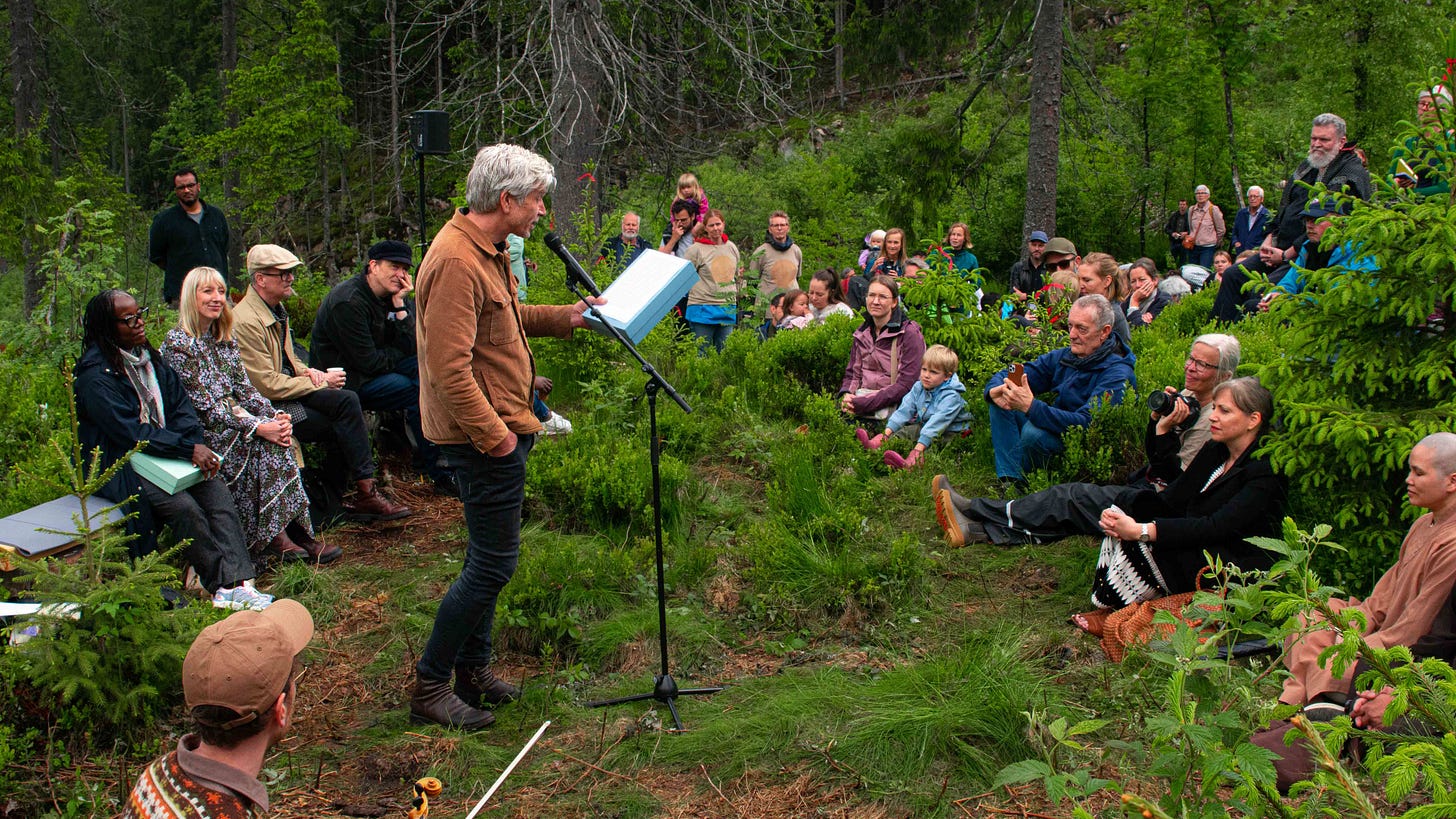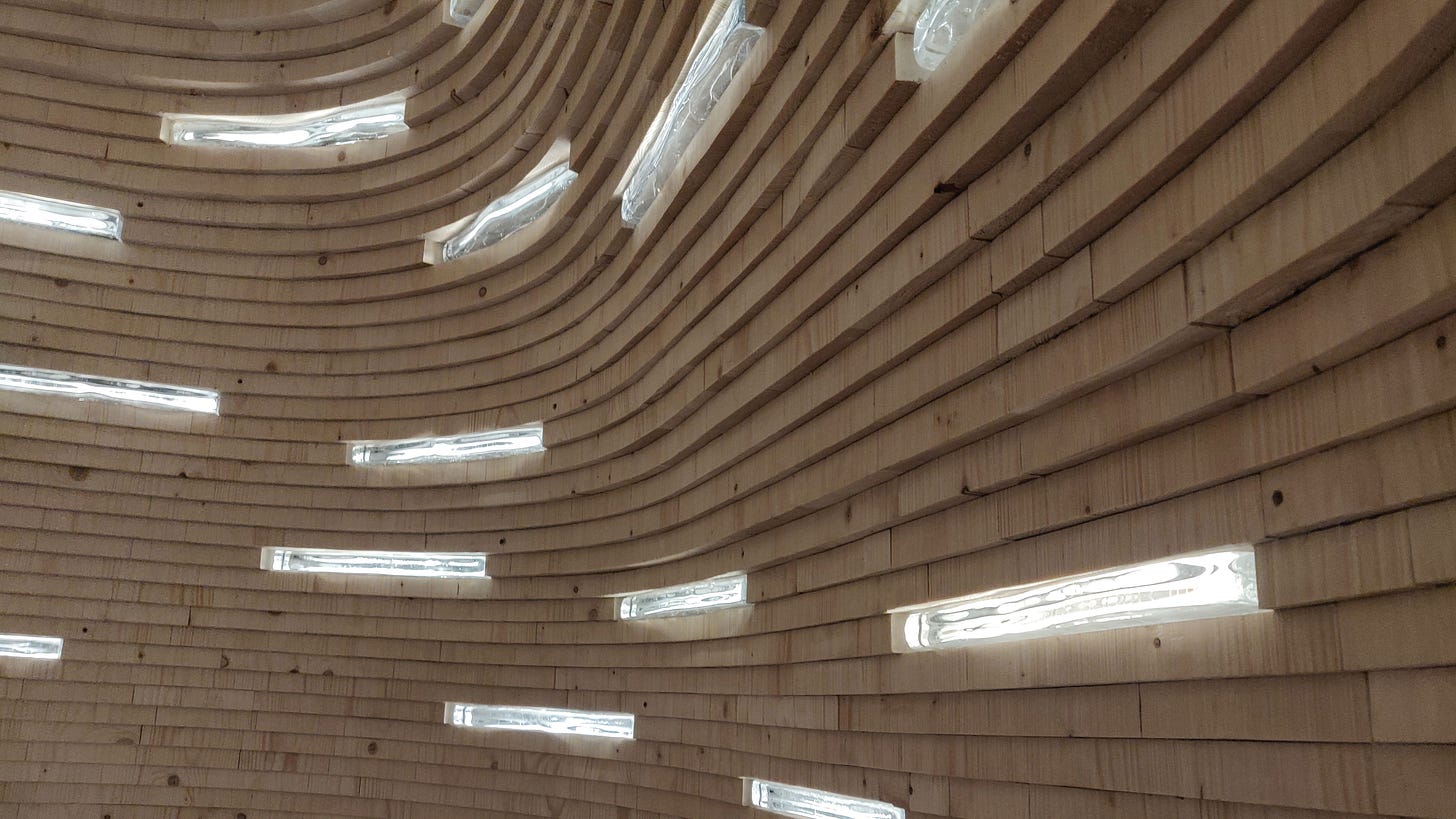The secret books that no-one can read
The Long-termist's Field Guide: 1,000 Ideas For The Next 1,000 Years
You’re reading The Long-termist’s Field Guide, a newsletter about long-term thinking. This edition is about the Future Library in Norway, where some of the world’s most celebrated authors are writing a cache of secret books that won’t be published until the 22nd Century
A few weeks ago, I finally got to meet a long-termist hero of mine: the Scottish artist Katie Paterson. We spoke in a room full of ancient dust.
At Ingleby Gallery in Edinburgh, Paterson had placed almost 370 glass vials of crushed material in a row along the wall, each one weighing 21g – the amount that a Massachusetts doctor once claimed was the weight of the human soul. It’s an artwork called Requiem.
The vials start with some of the most ancient substances known to science – pre-solar grains from meteorites, four-billion-year-old metamorphic rocks, and Earth’s oldest fossils. Then, gradually, as you walk along the row, they get younger and younger, spanning deep time, until you’re in the Anthropocene.
There you see powdered fragments of pottery from South America, a pulverised watch, or far darker samples, like the crushed branch of an irradiated tree from Hiroshima. It’s one of the most tangible, striking depictions of humanity’s role within deep time I’ve seen. I’ll be featuring it in a series of short films I’m making for the BBC, out in autumn.
It wasn’t the only one of Paterson’s artworks I’d encounter last month. Following our conversation in Edinburgh, she invited me to Norway to see the Future Library – one of her most ambitious and influential projects.
Every year since 2014, she and a group of trustees have commissioned a well-known author – Margaret Atwood went first – to submit a book that won’t be read for 100 years. They will continue soliciting manuscripts until 2114, when a small forest north of Oslo will be cut down to provide the paper for the books.
On 12 June, I joined more than 200 people to attend the annual Future Library ceremony, held within in the forest itself. Surrounded by the young trees - now around 1m tall - we watched as the Zimbabwean novelist Tsitsi Dangarembga and Norwegian author Karl Ove Knausgård formally handed over their secret manuscripts. Later, the stories would be placed inside glass drawers within the “Silent Room” – a small wooden cave-like space on the fifth floor of Oslo’s main city library.
You can read about my trip to Future Library in an article published on BBC Future today: “The Norwegian Library with unreadable books”. It tells the story of the project so far, and the lessons that might be drawn from it for long-term thinking.

For Field Guide readers, here’s a short summary, drawing out what I admire most about the Future Library project:
Future generations are given autonomy
What kind of legacy should we seek to leave behind for unborn generations? For some - even in the long-termist space - it’s about imparting their will onto the future. However, I believe the best legacy we could leave behind for unborn people is not a monument to our own glory or a locked-in expression of present-day values – it's the ability to choose.
Paterson and the trustees have designed the Future Library project so they can pass a baton to their successors, who crucially, will get to decide how to shape it after they are gone – choosing their own authors, deciding how they want the books to be published, and so on.
There’ll also be challenges ahead that require adaptation. As the author David Mitchell (2015) pointed out when we spoke in the forest, perhaps the annual ceremony will evolve into an unmanageable "arboreal Glastonbury", with too much crowding each year. "But it's sort of an act of faith in the capacity of future trustees and organisers to meet problems, anticipate them, and handle them," he told me.
A long view rooted in a community, not a single person
Caring about unborn generations is difficult on your own. That’s why the community around the Future Library project – with its own traditions and rituals - is so important. As well as the core team working on the project in Norway (who, incidentally, is 100% female), there is a growing “Future Library family” of writers, artists, policy-makers and Oslo residents.
I’ve seen other symbolic artworks reaching for posterity that are far less collaborative, but I would bet Paterson’s work and the ideas underpinning will endure for longer. There’s a Wittgenstein quote I like that speaks to this: “The strength of the thread does not reside in the fact that some one fibre runs through its whole length, but in the overlapping of many fibres.”
It’s a genuine gift to future people
It's rare that our generation can say we are genuinely giving something to our descendants. Certainly the 7.8 billion people alive today will leave behind plenty of positive heirlooms – classic songs, exquisite objects, grand buildings or movie masterpieces - but is it a truly selfless gift if you enjoy it first?
That said, Future Library is not an act of sacrifice either: caring about tomorrow’s generations needn’t be zero-sum, you needn’t take from the present to give to the future. As I write in the BBC article, there are many other indirect benefits from the project.
It’s hopeful, not doomist
In her work, Paterson doesn’t ignore the darker side of humanity – consider Requiem’s crushed samples of pollution, warfare, or atrocities. But amid the harms of the Anthropocene, Future Library is a statement of hope.
As the author Mitchell wrote in the notes accompanying his contribution in 2015: "Its fruition is predicated upon the ongoing existence of Northern Europe, of libraries, of Norwegian spruces, of books and of readers."
—
To discover more about Paterson’s work, I’d recommend her TED talk or website: it all began with her idea to set up a telephone hotline that connected callers to a melting glacier in Iceland…
The Long View - my upcoming book
This book is not a secret one, but I don’t think I’ve mentioned it on the newsletter until now. For the past 3-4 years, I’ve been working on a book called The Long View, which is about why we need to transform the world’s sense of time. It’s still a few months away from publication (early 2023, with the imprint Wildfire), but I received the first proofs recently, and gosh, it’s really exciting to see the words on the page…
Part I of The Long View charts a history of how people’s awareness of past, present and future evolved over the centuries, before exploring the systemic pressures that have fostered an age of short-termism today. Part II dives into the mind: looking at the psychology of time perception, from cognitive biases to how language can lengthen (or shorten) our perspectives. And in Part III, I explore what it takes to be more “long-minded”, profiling various artistic, philosophical, scientific and indigenous groups –each with their own particular timeviews, but all of them converging on the belief that longer-term thinking matters.
An offer: if you would like to be part of a small group of early readers of The Long View ahead of publication, I would love to hear from you. All that I would ask is that – if you like it – you tell someone. (Or even better, pre-order/buy them a copy!) Word-of-mouth matters hugely to first-time authors like me, so you could really help me make the book a success. Send me a note! You can reach me by replying directly, or at richard.fisher@gmail.com.
Thanks very much for reading, have a lovely weekend.
best wishes,
Richard
Follow me @rifish on twitter, my website of writing, or @thelongtermist on instagram.
Previous editions:




